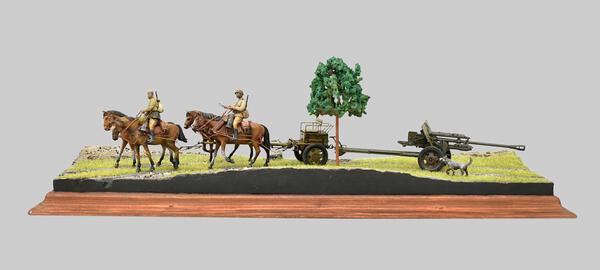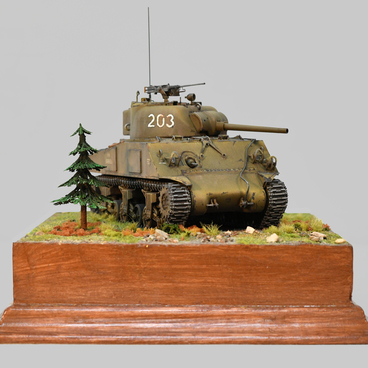The museum houses a model of a Soviet horse-drawn carriage with a 76mm gun.
The artillery crew of the 76mm regimental gun included seven people — a gun commander and six gun numbers. Each number had tasks to perform during the battle and the maintenance of the gun, as well as on the march. Along with their duties, each of the numbers was to be ready to replace their crewmen in case they became a casualty.
The crew procedure was directed by a senior sergeant, who monitored the battlefield, determined the target, calculated the gun pointing angle, selected the type of ammunition, and provided general guidance to the crew.
The first number, a junior sergeant, acted as the gunner. The second gun number was the breechblock operator, whose main duty was to close the breech after discharging and open it after firing. The third number was the loader who loaded the gun with shells and ensured that the type of ammunition corresponded to the command of the senior sergeant. The fourth number — the setter — supplied the shells to the loader and set the type of fuse.
The fifth and sixth gun numbers were limber gunners, whose main task was to provide shells and pass them to the setter. Before the battle began, both limber gunners washed cartridges and removed grease and dirt from them. These numbers also had to remove empty cartridges from the position.
The gun ammunition was supposed to consist of 154 fragmentation grenades, 40 armor-piercing tracer shells, and 6 canister rounds.
The artillery crew of the 76mm regimental gun included seven people — a gun commander and six gun numbers. Each number had tasks to perform during the battle and the maintenance of the gun, as well as on the march. Along with their duties, each of the numbers was to be ready to replace their crewmen in case they became a casualty.
The crew procedure was directed by a senior sergeant, who monitored the battlefield, determined the target, calculated the gun pointing angle, selected the type of ammunition, and provided general guidance to the crew.
The first number, a junior sergeant, acted as the gunner. The second gun number was the breechblock operator, whose main duty was to close the breech after discharging and open it after firing. The third number was the loader who loaded the gun with shells and ensured that the type of ammunition corresponded to the command of the senior sergeant. The fourth number — the setter — supplied the shells to the loader and set the type of fuse.
The fifth and sixth gun numbers were limber gunners, whose main task was to provide shells and pass them to the setter. Before the battle began, both limber gunners washed cartridges and removed grease and dirt from them. These numbers also had to remove empty cartridges from the position.
The gun ammunition was supposed to consist of 154 fragmentation grenades, 40 armor-piercing tracer shells, and 6 canister rounds.





